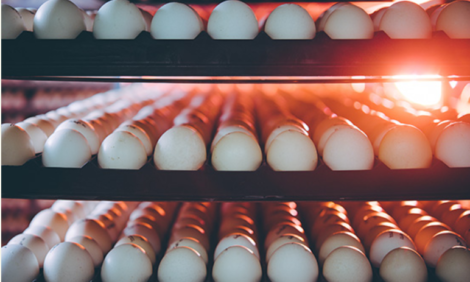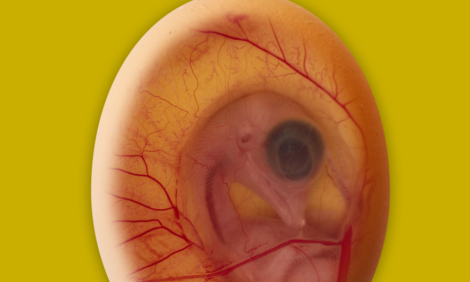



Should CCTV Be Installed in Slaughterhouses?
UK - An all-seeing eye and independent monitoring would ensure the maximum quality of animal welfare conditions in slaughterhouses.This was the central argument for Crawley MP Henry Smith in a debate on welfare conditions in slaughterhouses in the UK in the House of Commons this week.
Mr Smith, a self-confessed vegetarian, said that he was calling for CCTV cameras to be installed in slaughterhouses as a matter of animal welfare.
He said that the vets, who are on site in slaughterhouses, are not everywhere at once, and too many incidents have been missed.
The debate, which had been scheduled for some time, followed the recent incident in a Yorkshire slaughterhouse where animal welfare campaign group, Animal Aid, had taken video footage of slaughtermen ill-treating sheep during Halal slaughter.
“The recording shows appalling violence. The Food Standards Agency has so far suspended the licences of three workers, and I understand it is also building cases for prosecutions. Terrible as those actions are, that slaughterhouse is not, unfortunately, an anomaly,” said Mr Smith.
Mr Smith said that given the scale of the industry, only a small amount would be needed to install CCTV across all slaughterhouses in the UK.
He said that earlier recordings revealed animals being kicked, slapped, stamped on, picked up by fleeces and ears, and thrown into stunning pens.
“They recorded animals being improperly stunned and coming round again, or suffering painful electrocution instead of being stunned.
“Cameras have also captured animals being deliberately and illegally beaten and punched, and burned with cigarettes. Workers have been caught hitting pigs in the head with shackle hooks, and using the stunning tongs deliberately to cause pain by sending electric shocks through animals’ ears, noses, tails, legs and abdomens, and even, in one case, through an open mouth.
“The key point I wish to convey is that not one of the illegal acts filmed was detected by the Government-appointed on-site vets or the slaughterhouse operators, who have ultimate responsibility for animal welfare.”
Mr Smith said that the current regulatory system fails animals badly.
He added that workers do know the law and they know how to abide by it, but investigations have shown that it is routinely flouted when they think no one is watching.
“Cameras could help prevent routine suffering by detecting institutionalised poor practice, such as the illegal stunning and slaughter methods used in at least four of the slaughterhouses videoed by Animal Aid,” Mr Smith told the Commons.
“Any vet who saw these methods would have been able to step in and advise retraining for the staff involved.
“And, of course, those who do cause deliberate unnecessary suffering to animals are much more likely to be caught. The recordings, when properly monitored, provide evidence that will allow food business operators and the Food Standards Agency to take decisive action.”
The House heard that the Royal Society for the Prevention of Cruelty to Animals welfare standards introduced the requirement for installation of CCTV in abattoirs from 2011 and all Freedom Food scheme-approved slaughterhouses have had to install effective CCTV systems and store recordings, and make them available to Freedom Food and RSPCA field staff.
Mr Smith said that the slaughter industry has not made a good name for itself but he added that the major supermarket and wholesale chains were now insisting on CCTV in slaughterhouses.
IN reply agriculture minister George Eustice said a report on CCTV in slaughterhouses by the Farm Animal Welfare Committee had been published this week.
“The report by the FAWC concludes that there are many benefits to CCTV in slaughterhouses, but also sounds a note of caution, stating that CCTV is no panacea, and while it can be a useful tool to complement existing enforcement and management, it cannot replace other management procedures and inspection regimes,” said Mr Eustice.
“It is tempting to conclude that the footage released by Animal Aid proves a point: that perhaps things like this would not happen if CCTV were in place. However, as my hon. Friend acknowledged, the reality is that the Bowood abattoir where Animal Aid secretly recorded its footage already has CCTV.
“The presence of CCTV did not prevent those apparent incidents, and the Bowood case is not the first example of apparent welfare breaches, including deliberate abuses, found in slaughterhouses where CCTV is present.
“My conclusion is that CCTV can only ever be part of the answer to improving animal welfare and preventing abuses. It needs to be backed up with other monitoring methods.”
Mr Eustice said that the FAWC report shows that there are benefits to CCTV.
The committee concludes that it has a useful role in recording incidents, helping enforcers by enabling them to look at the footage to check what actually happened. It can also be used for evidence where welfare abuses are suspected.
But, he added that the benefits of CCTV go wider than its role as a possible deterrent. For instance, it could allow observation of activities in small confined spaces where it would otherwise be difficult for the official veterinarian to observe.
The report also concludes that CCTV can provide more accurate ante-mortem inspection in the lairage areas.
The last time the Government looked at the issue of making CCTV in slaughterhouses compulsorty was in 2012.
At the time it concluded that mandatory CCTV was not the right way to go.
“However, I have always been clear that we keep the issue under review and that I have an open mind. I have just received the report from the Farm Animal Welfare Committee, which examines the arguments and evidence for the compulsory installation of CCTV in slaughterhouses,” Mr Eustice said.
“I want to consider its findings fully before reaching a final conclusion.”
After the debate, the Bitish Poultry Council said: “The debate on CCTV in slaughterhouses, initiated by Henry Smith MP, is a timely one and to be welcomed. It gives an opportunity to show how technology is helping the poultry industry improve efficiency in how we feed the nation.”
It added: “BPC members have found CCTV an incredibly useful resource for managing many aspects of the slaughter process, and this tool is made readily available to the authorities.
“We should bear in mind that CCTV is not an absolute guarantee of animal welfare.
“A responsible poultry slaughterhouse always uses it in conjunction with high hygiene standards, comprehensive employee training, and independent auditing. Good animal welfare practices are more likely to occur with good training and motivation and a management system that is able to respond immediately to incidents.
“Public confidence within the meat sector will no doubt have been knocked by the recent images taken by Animal Aid, and available on their website. Producers have an important duty of care to animals and it is important that the right checks and balances are implemented to ensure appropriate accountability. Responsible producers of meat production will never condone sub-standard or illegal behaviour and the BPC supports all enforcement measures taken to eliminate it.”








